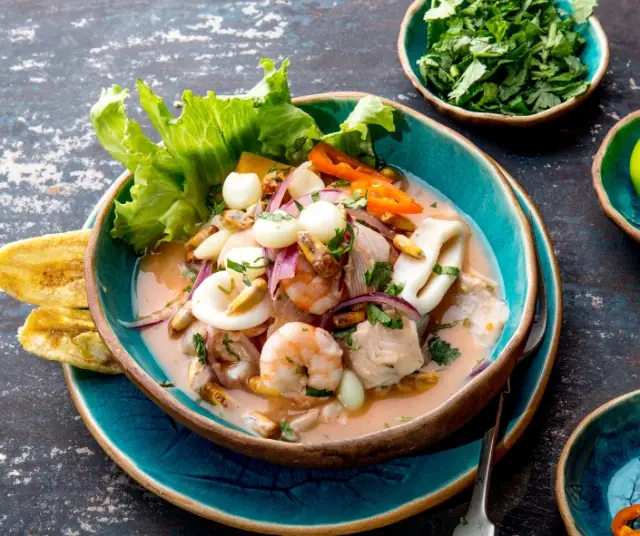Peru, a country that lies at the intersection of history, culture and biodiversity, stands out not only for its astonishing geography that spans from the Pacific coast to the Amazon rainforest, but also for its exceptional and varied gastronomy. Peruvian food has gained international recognition as some of the most exciting and delicious in the world, fusing native ingredients with innovative cooking techniques.
Peruvian cuisine is a fascinating kaleidoscope of flavors that is nourished by the cultural and geographical wealth of the country. Its uniqueness lies in the harmonious fusion of indigenous culinary traditions with influences from around the world, thus creating an exceptionally diverse gastronomic heritage.
At the base of this fusion lies the abundance of native ingredients that come from the coast, the mountains and the Peruvian jungle. From fresh seafood from the Pacific coast to products grown high in the Andes, the variety of inputs offers chefs and cooks a unique palette to unleash their creativity.
Peruvian cuisine is a living reflection of the country's history, marked by the arrival of various cultures. The indigenous influence is manifested in the use of ingredients such as potatoes, corn and chili, which have become fundamental pillars of Peruvian gastronomy. Added to this are the contributions of African, Asian and European cuisine, the result of immigration and mixing over the centuries.
Peruvian culinary technique is as diverse as its ingredients. From the ancient hot stone cooking of the Incas to sophisticated contemporary molecular cooking techniques, Peruvian cuisine has constantly evolved. Peruvian chefs have known how to combine tradition with innovation, creating dishes that respect cultural roots but also surprise with their originality.
2. Cebiche: A Feast of Freshness and Marine Flavor
Ceviche, considered the national dish of Peru, is a clear example of the influence of local ingredients on gastronomy. This emblematic dish combines fresh fish, preferably sea bass or sole, with lemon, chili, cilantro and red onion. The magic lies in the "cold cooking" technique, where the fish is "cooked" in the citrus juice. Accompanied by sweet potato, corn and canta, ceviche is an explosion of freshness and flavor that represents the very essence of Peruvian cuisine.
3. Lomo Saltado: A Meeting of Gastronomic Traditions
Lomo saltado is a wonderful amalgamation of flavors, combining Peruvian tradition with Chinese influences. This dish, born from Chinese immigration in the 19th century, presents pieces of beef sautéed with onion, tomato, yellow pepper and cilantro, all accompanied by rice. The fusion of the Chinese stir-fry technique with Peruvian flavors creates a unique culinary experience that has conquered local and international palates.
4. Ají de Gallina: A Creamy and Spicy Experience
Ají de gallina is a dish that has conquered hearts with its unique mix of ingredients. Prepared with shredded chicken, yellow chili pepper, milk-soaked bread, walnuts and Parmesan cheese, this dish offers a combination of creamy and spicy flavors. Served on a bed of rice, ají de gallina is a tribute to the richness of Peruvian cuisine, where softness and intensity are found in every bite.
5. Anticuchos: A Feast of Flavors on Skewers
Originating from pre-Columbian times, anticuchos are skewers of marinated meat, usually beef heart, that are cooked on the grill. Paired with a sauce of ají panca, garlic and spices, anticuchos are a delicacy that has been passed down from generation to generation. This dish reflects the ability of Peruvians to transform humble ingredients into an extraordinary gastronomic experience.
6. Tacu Tacu: Creativity in Gastronomic Recycling
Tacu tacu is a dish that exemplifies Peruvian ingenuity in using leftovers to create a delicacy. It consists of rice and beans mixed together and then fried, creating a texture that is crispy on the outside and soft on the inside. It is commonly served with fish, seafood or grilled meat. Tacu tacu stands out for its simplicity and comforting flavor, proving that creativity in the kitchen is often born of necessity and tradition.
7. Peruvian Desserts: A Sweet End to an Unforgettable Experience
Peruvian sweets are equally impressive, with desserts that combine native flavors with European techniques. Suspiro a la Lima, a cream of condensed milk and egg yolk, is a classic that conquers with its sweetness. Other standouts include mazamorra morada, a jelly made from purple corn, and causa limeña, a potato pie filled with tuna or chicken.
8. Typical Drinks: A Toast to Peruvian Culture
In the vibrant mosaic of Peruvian gastronomy, typical drinks occupy a prominent place, offering a fascinating tour of the country's native flavors and cultural traditions. From the famous Pisco Sour to traditional infusions, Peruvian drinks not only quench thirst, but also tell stories of the rich heritage of this land.
At the epicenter of Peruvian cocktails is the Pisco Sour, an internationally recognized icon. This exquisite mixture of pisco, grape liquor, lemon juice, gum syrup and egg white, offers a perfect balance between sour, sweet and bitter. Beyond being a simple drink, the Pisco Sour is an emblem of Peruvian hospitality and a testament to the skill of local mixologists.
Chicha morada is another gem in the repertoire of Peruvian drinks. Made from purple corn, this sweet and vibrant drink has been consumed since pre-Columbian times. In addition to its pleasant flavor, chicha morada has significant cultural value, as it symbolizes the connection with the ancient civilizations that populated the region.
Coca tea, with its stimulating and digestive properties, has become a ritual drink in many parts of Peru. Extracted from coca leaves, this infusion not only offers a boost of energy, but also reflects the historical relationship that the Peruvian people have with the coca leaf, considered sacred by ancient Andean cultures.
You cannot ignore api, a hot drink made from purple or yellow corn. Mainly consumed in the Peruvian mountains, api is comforting and nutritious, often accompanied by empanadas or tamales. It is an example of how local ingredients are harmoniously incorporated into everyday life and celebrations.
